Emergencies come in all shapes and sizes. Regardless of whether you’re out hiking or snowmobiling and need medical assistance, or if there’s a catastrophic event, there’s a certain peace of mind that comes with knowing that you have the means to get in touch with your emergency contacts.
The 7 best radio walkie talkies for emergencies.
- Archshell Rechargeable Long-Range Two-Way Radio UHF 400-470MHZ Walkie Talkies
- Motorola T801 Talkabout
- Midland – LXT600VP3 36-Channel FRS Two-Way Radio Walkie Talkie
- ESYNIC 4-PC Rechargeable Walkie Talkies
- Retevis RT22 Walkie Talkies
- Moico Long-Range Walkie Talkies
- EKOOS Walkie Talkies Long-Range for Kids and Adults
This article will provide details for each of the seven options and will also discuss a few other types of emergency communication options.
These Radio Walkie Talkies Aren’t Your Childhood Toys
If you loved playing with walkie talkies as a kid, you probably remember the static in the signal and not being able to be much more than 100-feet apart. These two-way radios are much more robust than that. Most offer clear communication signals of a mile or more.
Non-Licensed Two-Way Radios
These walkie talkies are all battery operated and don’t require an FCC (Federal Communications Commission) license.
Note: The use of FRS (Family Radio Service) radios used to require an FCC license, but the regulation was updated in 2017 to allow the use of channels 1-7 and 15-22 for radios with 2 Watts or less; channels 8-14 still require the use of ½ Watt or less for non-license use; otherwise channels 8-14 are reserved for licensed GMRS (General Mobile Radio Service).
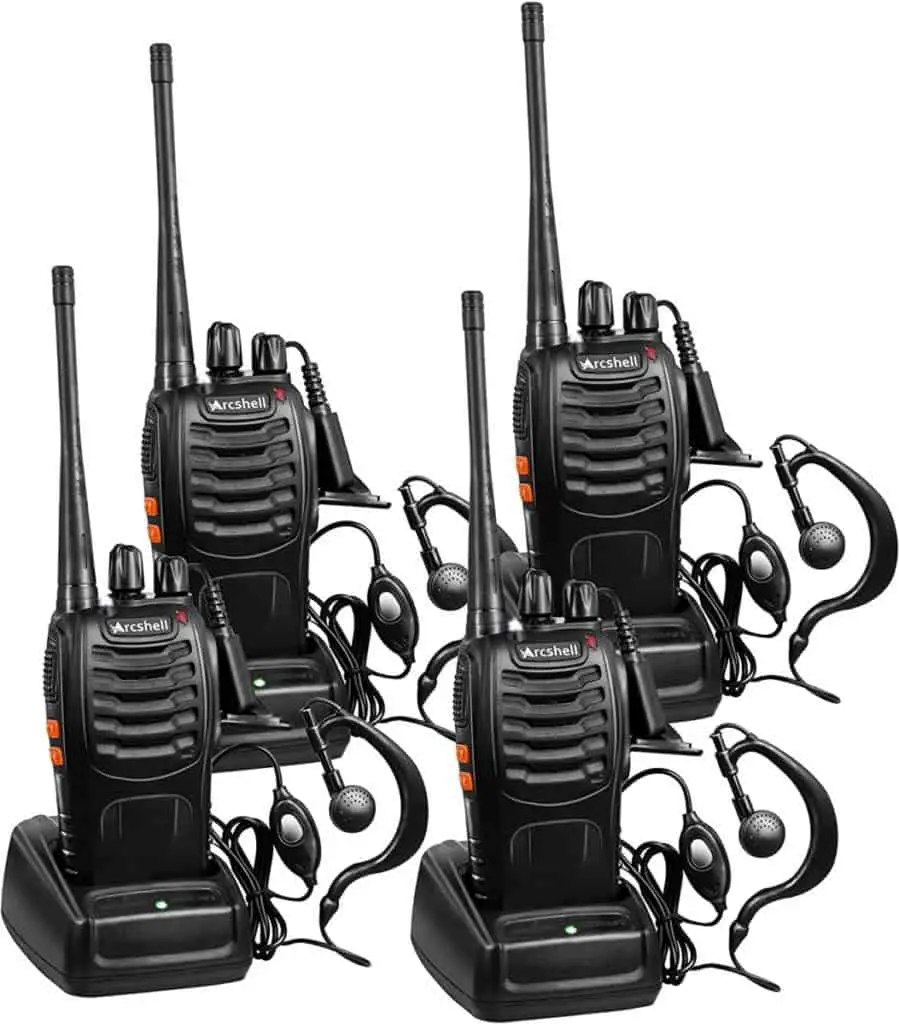
These two-way radios have an impressive 4.5 out of 5 possible stars rating – but that’s not the most impressive part. Nearly 3,500 users have rated these and they still have a rating that high.
The Archshell Rechargeable is lightweight and water-resistant. It has 16 pre-programmed channels calibrated to mirror the same frequencies of all other radios in the box. It’s earphone (included) compatible, so you can be the only one who hears the other side of the conversation. It also has automated Voice Operated Transmission (VOX) so you can use it in hands-free mode.
This rechargeable battery-operated two-way radio comes with a cradle charger and will fully charge in about 2.5 hours. Its charge will also last somewhere between 8 and 96 hours depending on how much you use it for either communication purposes or with its built-in LED flashlight.
In an area with no obstructions, it has a range of up-to five miles. It uses UHF waves, so it has less chance of interference with other wireless systems and provides better transmission around:
- Concrete,
- Wood, and
- Steel obstructions.
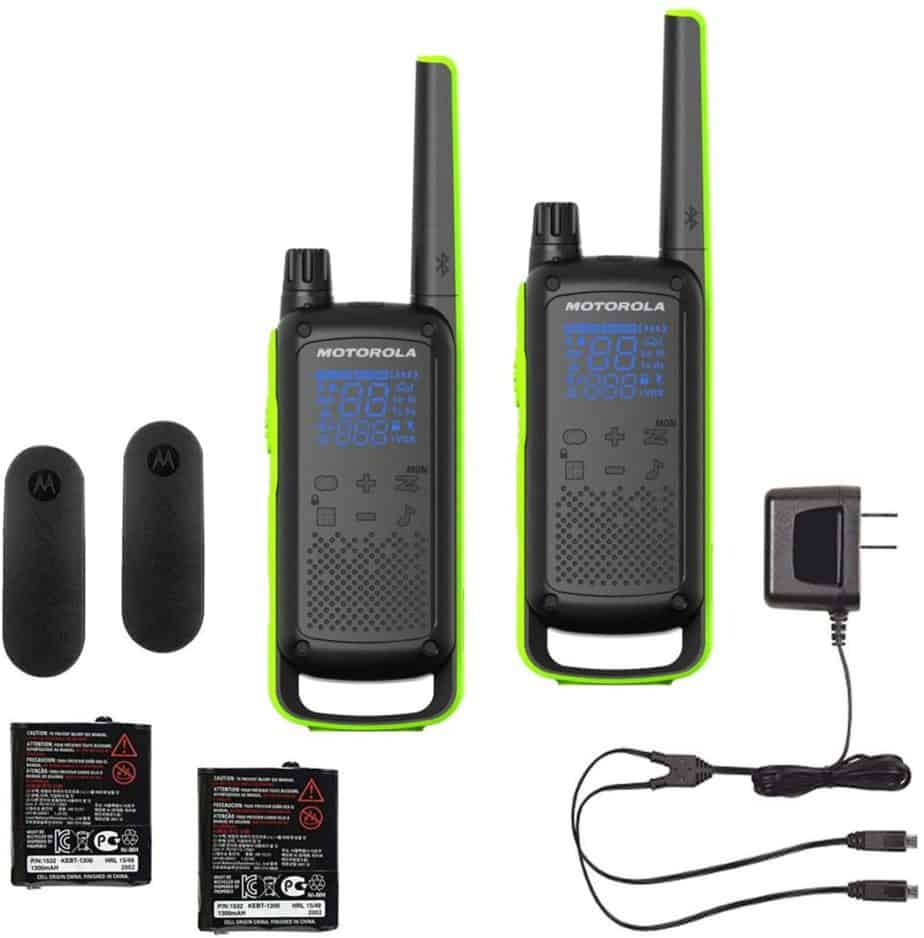
The Motorola two-way radio set has a consumer rating of 4.7 out of a possible 5 stars. This device offers several emergency functions including:
- 22 channels with 121 available privacy codes,
- Off-grid group messaging or broadcasting,
- The ability to share your location while you’re offline,
- Seven NOAA (National Oceanic and Atmospheric Administration) weather alert channels,
- An additional four non-NOAA weather alert channels, and
- Depending on terrain and conditions, up-to a 35-mile voice transmission and 20-mile data transmission range.
This device can also attach to your cellphone’s Bluetooth to increase your communication options. Once you have downloaded the app and linked your smart phone to the device, the T801 becomes a modem you can use to send messages without having to be connected to the cell service.
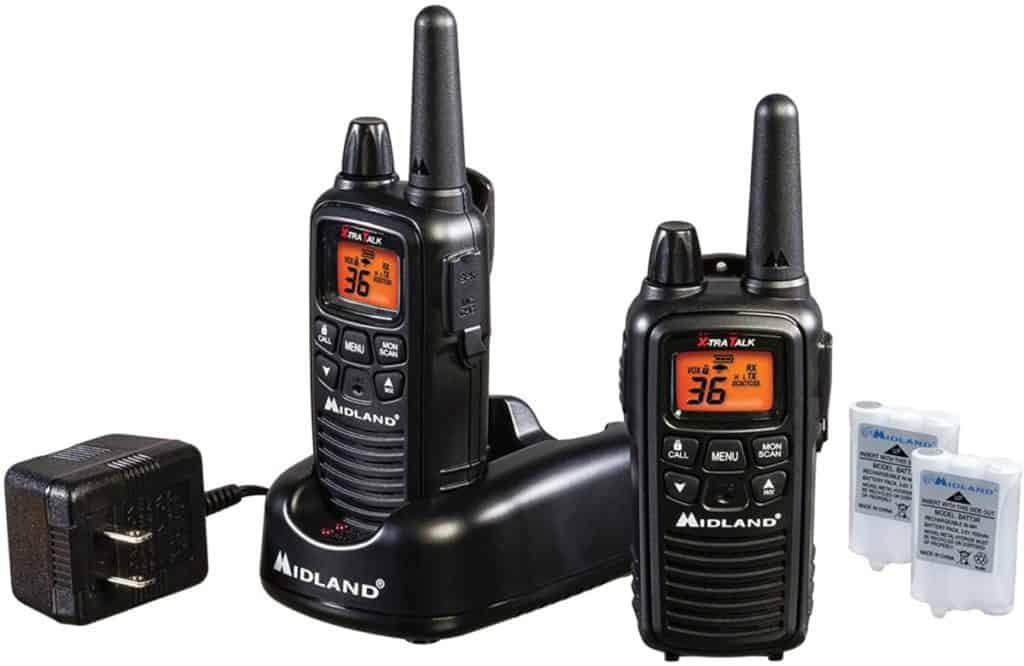
This two-way radio option has a 4.1 out of a possible 5 stars rating.
The manufacturer claims it has an up-to 30-mile range in ideal conditions. One reviewer has confirmed a very clear 10-mile transmission distance in the woods while out camping and hiking and another said up-to two-miles on a lake.
This device offers:
- 22 channels,
- 121 privacy codes,
- Weather alerts, including NOAA, with a scanning function for the most relevant weather,
- Water resistant construction, and
- VOX hands-free communication options.
These radios have both a rechargeable battery pack or can use 3-AAA batteries (not included).
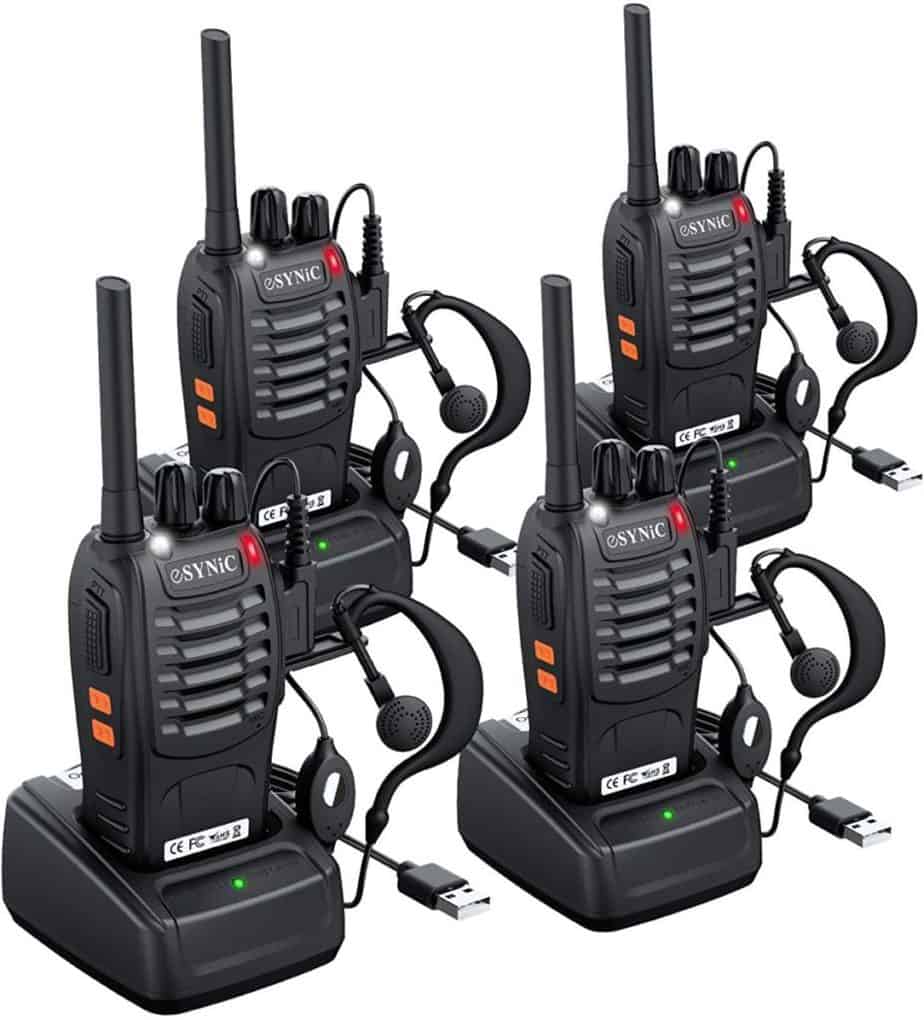
These two-way radios have a 4.1 out of a possible 5-star rating. Their large-capacity Li-ion rechargeable battery takes about 2-3 hours to charge and then allows for 8-9 hours of continuous use.
These walkie talkies include:
- 16 channels,
- Up-to three miles of range in ideal conditions,
- 50 different alert tones,
- A USB power-bank charger for the battery,
- An emergency alarm function,
- An LED flashlight, and
- An 18-month warranty with lifetime customer support.
This set comes with earpieces so you can have privacy during your conversations.
Note: The link for this product also offers product discounts and promotional codes.
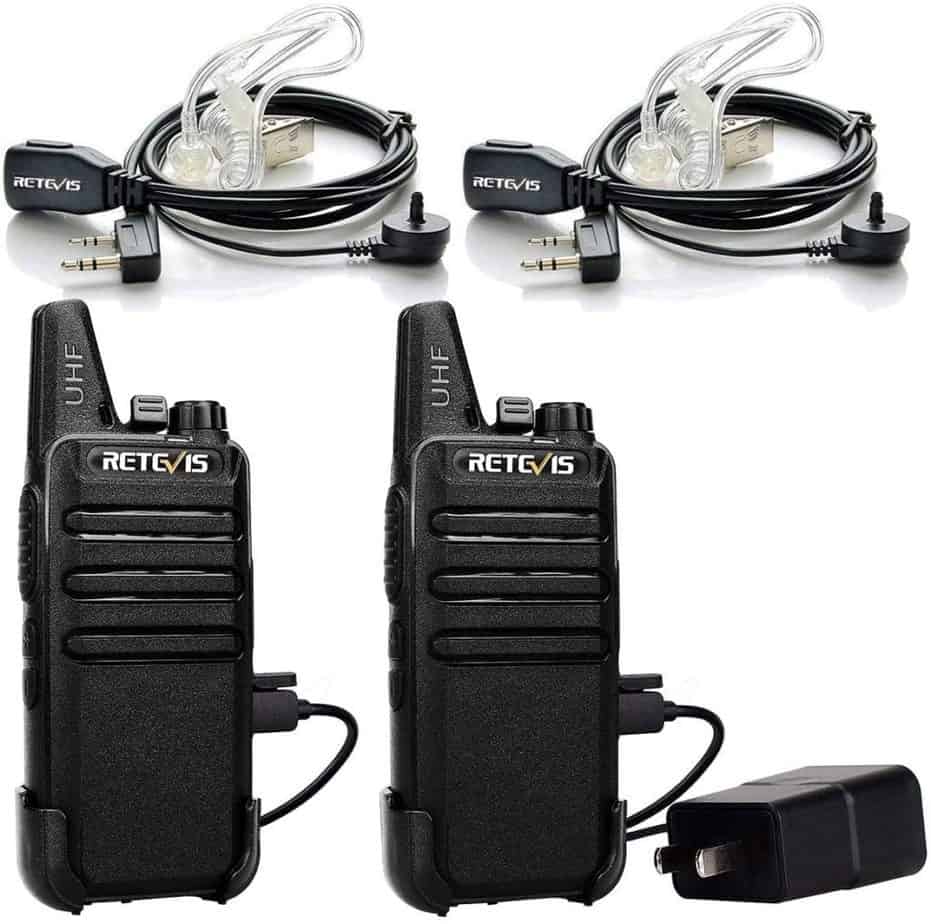
These 4.4 out of possible 5-star rated two-way radios are light-weight and pocket-sized. They also have a belt-clip option.
The earpieces that come with these radios are clear, so they’re not as easy to detect.
These walkie talkies are pre-set to coordinate with one-another straight out of the box. You won’t have to worry about setting the frequency and/or privacy settings to be able to immediately communicate with one another.
With this radio set you will have access to 16 FRS radio channels and up-to 121 different privacy codes. Some additional features are:
- A channel lock to prevent accidental channel changes,
- An emergency alarm
- VOX hands-free operation,
- A rechargeable Li-ion battery with charger cables, and
- Weatherproof construction.
One reviewer talked about the ability to use this product without issue for a 500-foot radius “through multiple cinder block walls.”
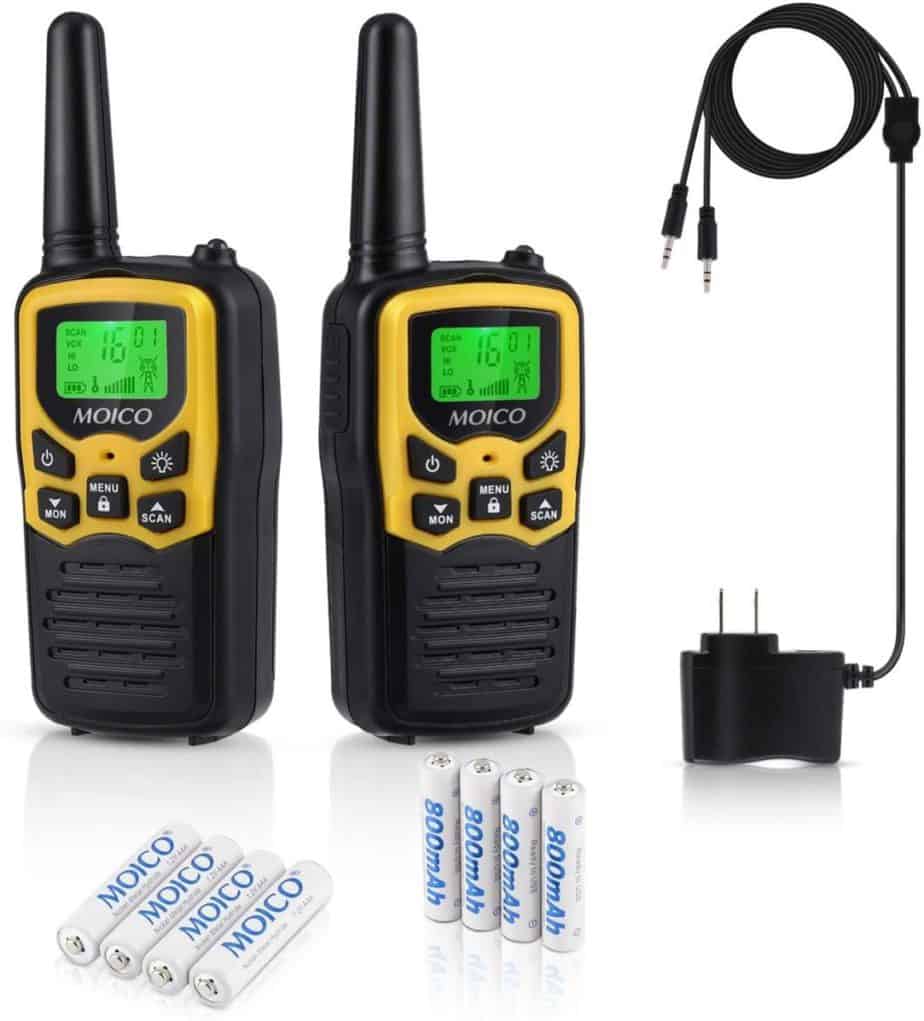
These 4.3 out of a possible 5-star rated rechargeable walkie talkies offer up-to 15-hours of continuous use and 40-hours of standby time.
The manufacturer suggests it offers up-to 5-miles communication range in ideal circumstances and .6 – 1.2 miles of range in built-up or obstructed areas.
These two-way radios:
- Use 4-AAA rechargeable batteries per radio,
- Require 8-hours to fully charge (the charger is included),
- Have a backlit LCD display to show channel, volume, and battery charge,
- Have a built-in flashlight that can also act as an emergency beacon, and
- Give you the ability for hands-free use with the VOX function.
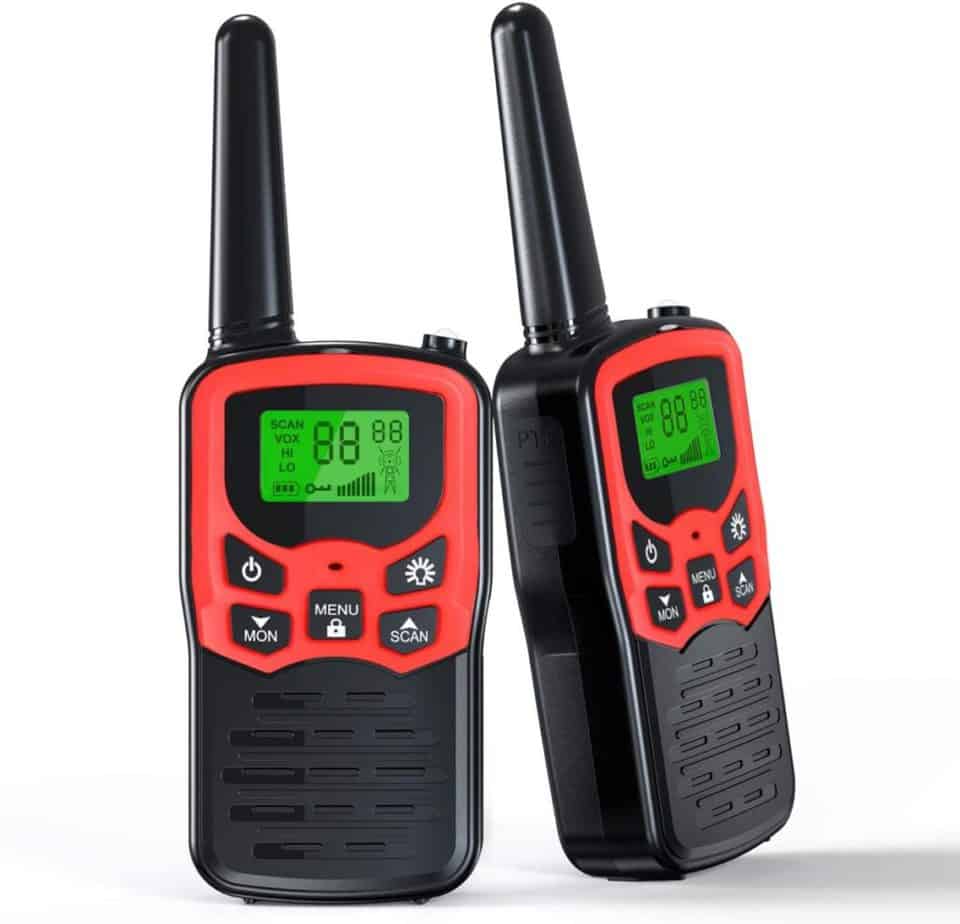
This set of two-way radios has a rating of 4.6 out of a possible 5-stars. The manufacturer says that it can work:
- Up-to ½ mile in a neighborhood,
- Up-to 3-miles on open water, and
- Up-to 5-miles in open areas with little-to-no nearby obstructions.
Here’s what actual users have found about its reliability and transmission distance:
- In normal conditions, one rater found it to work for about four city blocks in an area with buildings, traffic, and other radio signals.
- Another consumer talked about clear signals for over 2-miles on a golf course where there are houses, trees, and bushes the signal needs to navigate.
These radios have 22 standard FCC channels, but they also include GMRS channels (use of which does require an FCC license). The VOX feature also allows hand-free use of the radios.
The EKOOS’s built-in flashlight can also double as a flashing emergency signal and its backlit LCD screen is easy to read when you want to check:
- What channel you’re on,
- The current volume level,
- Whether or not the buttons are locked, and
- The current battery charge.
You’ll need to supply 4-AAA batteries for each device.
GMRS Walkie Talkies (FCC License Required)
For those who are interested in the ability to have more robust communication distances and are ready to buy an FCC license but don’t want to bother with HAM radio, the GMRS (General Mobile Radio Service) walkie talkies may be more along your lines of interest.

These two-way radios have nearly 500 individuals providing ratings and have a 4.5 out of a possible 5-star rating.
These devices use simple USB charging, so it opens up your charging options. They also:
- Allow you to use CHIRP software to customize one of the buttons to meet your communication needs,
- Have the ability to store up-to 16 channels
- Have a 2-watt transmission, which according to one reviewer, allows for between 2 – 3 miles of transmission in a suburban area and 3 – 4 miles in an open area,
- Have up-to 96-hours of standby time allowing for all-day use on a single charge,
- Come with clear earpieces with microphones, and
- Have VOX handsfree capability.
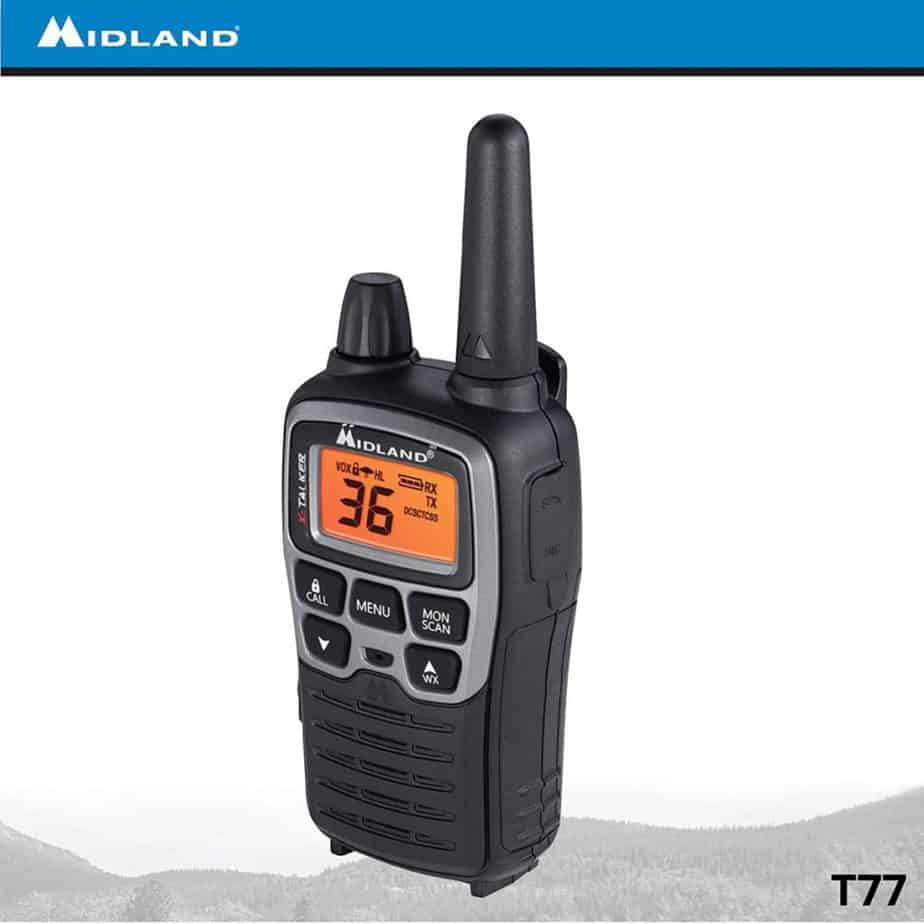
This set of two-way radios has a 4.3 out of a possible 5-star rating and claims to have up-to a 38-mile transmission distance, and even further in open areas with little-to-no obstructions.
Although the description says it’s a license-free radio, if you are going to use the GMRS service, you are required to have an FCC license. These radios also:
- Offer 10 weather scans and alerts, including NOAA weather updates,
- Have both an AC wall adapter or USB option for charging,
- Include 121 privacy codes along with the 36-channel options, and
- Contain VOX handsfree capacity.

This amped-up radio has a 4.2 rating out of a possible 5 stars from nearly 1,225 consumers.
It is often used in marine situations, so it is submersible/water resistant and designed to be durable. It is a VHF (Very High Frequency) radio with GMRS channel functionality. It has:
- Instant access to channels 9 and 16 for emergency situations,
- Access to international channels at 1, 3, or 6 Watts.
- Instant access to NOAA weather and hazard information along with emergency weather alerts,
- A noise-cancelling microphone,
- A Li-Ion battery for long battery life, and
- A rewind/say-again feature that will record the last 20-seconds of a conversation to make sure you capture important information.
This unit has a place to plug in a speaker on the top of it, but it is not compatible with standard earbuds.
Satellite (GPS) Communication Devices
Satellite devices are great when you are completely off-the-grid but need to be able to get weather alerts, have access to maps, and communicate with others. These devices also tend to have fewer range limitations but do require a satellite subscription. Satellite devices are typically much more expensive too.
Note: Some areas prohibit the use of satellite devices. Before using a satellite-powered device, make sure you know the local regulations and requirements.
Here are a few devices that can be helpful:
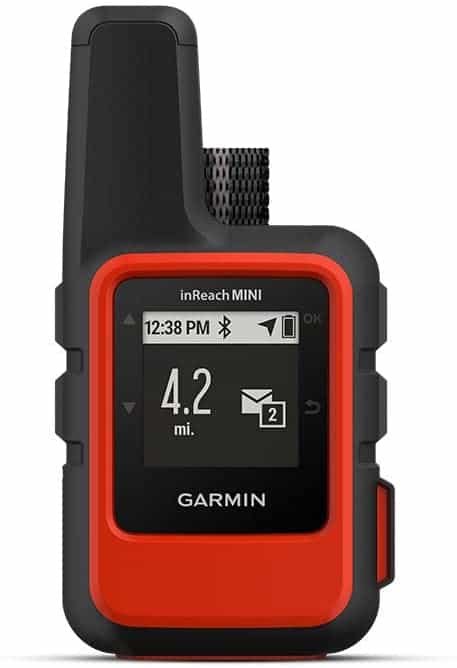
This communications device has a 4.5 out of a possible 5-star rating. This device allows you to:
- Connect to the “100 percentage global Iridium network,”
- Link with your mobile device’s Bluetooth to allow for critical communication options,
- Contact the interactive 24/7 search and rescue monitoring center,
- Access maps and NOAA charts that can be downloaded,
- Have access to weather notifications, and
- Durable and rugged design and construction.
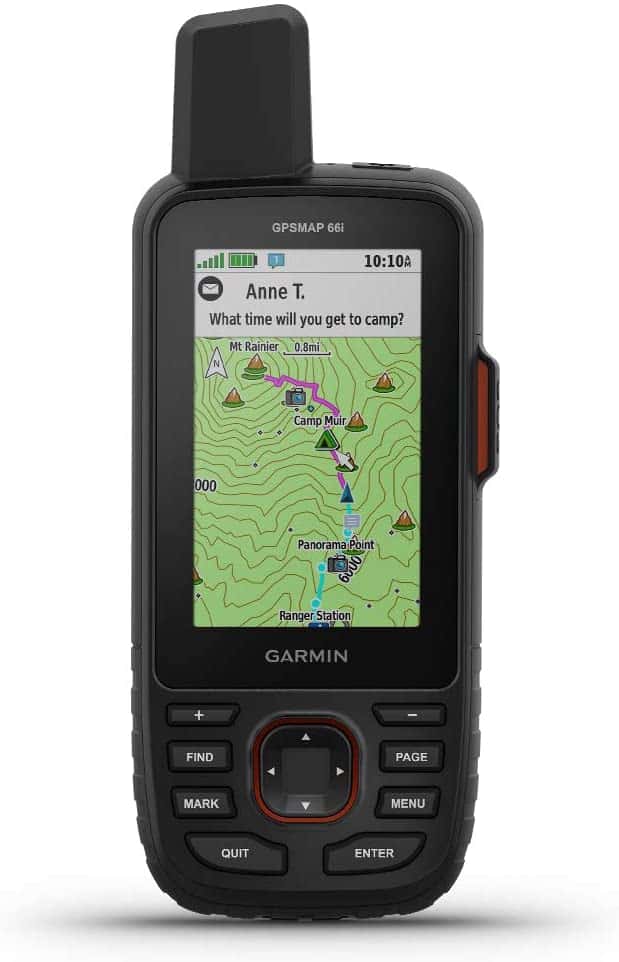
This particular device has a 4.4 out of 5-star rating. With it you can:
- Use the 3-inch color display for easy viewing of downloadable maps. This screen is designed to be easy to read in sunlight too.
- Have access to weather updates,
- Trigger an SOS to the 24/7 monitored emergency response center,
- Download maps, including topographical maps, and
- Feel secure with the long-lasting battery life.
Helpful Accessories
Having these devices won’t do you any good if you can’t keep them operational. If you’re in the middle of an emergency and need to be able to have the means to charge batteries, here are a couple options that you can consider:
Solar Chargers
Solar chargers are designed to allow you to connect your USB cords to the device and let the natural light work to charge your device(s). Two options could be the:
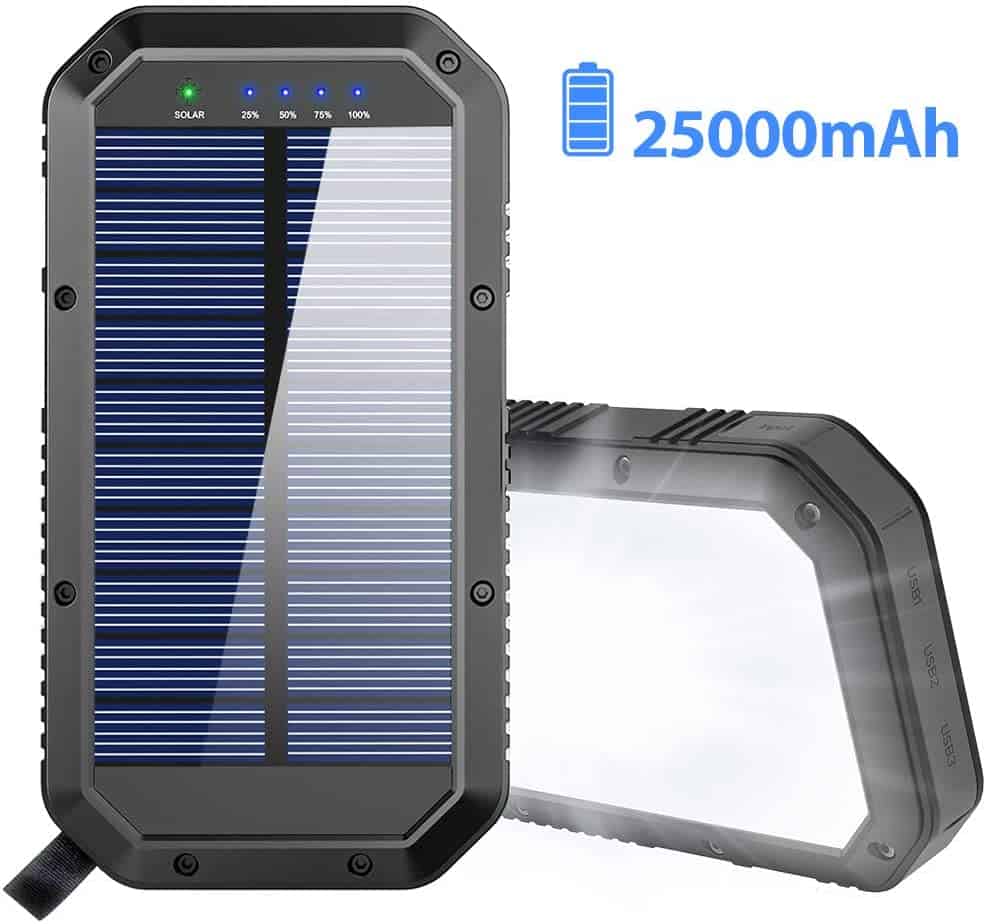
- 4.4 rated Solar Charger 25000mAh Battery Solar Power Bank or the
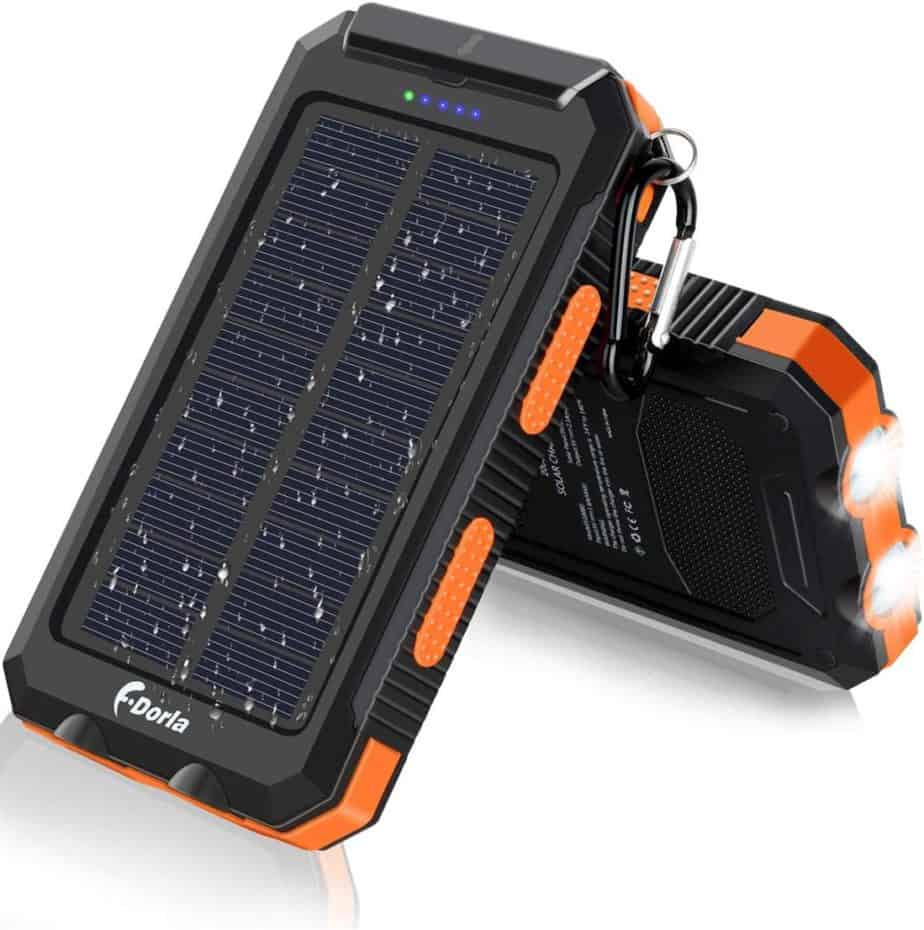
Campfire Chargers
Campfire chargers give you the ability to use the heat from your contained campfire stove to connect your USB cable and charge your device(s). If you think this sounds interesting, you can check out:
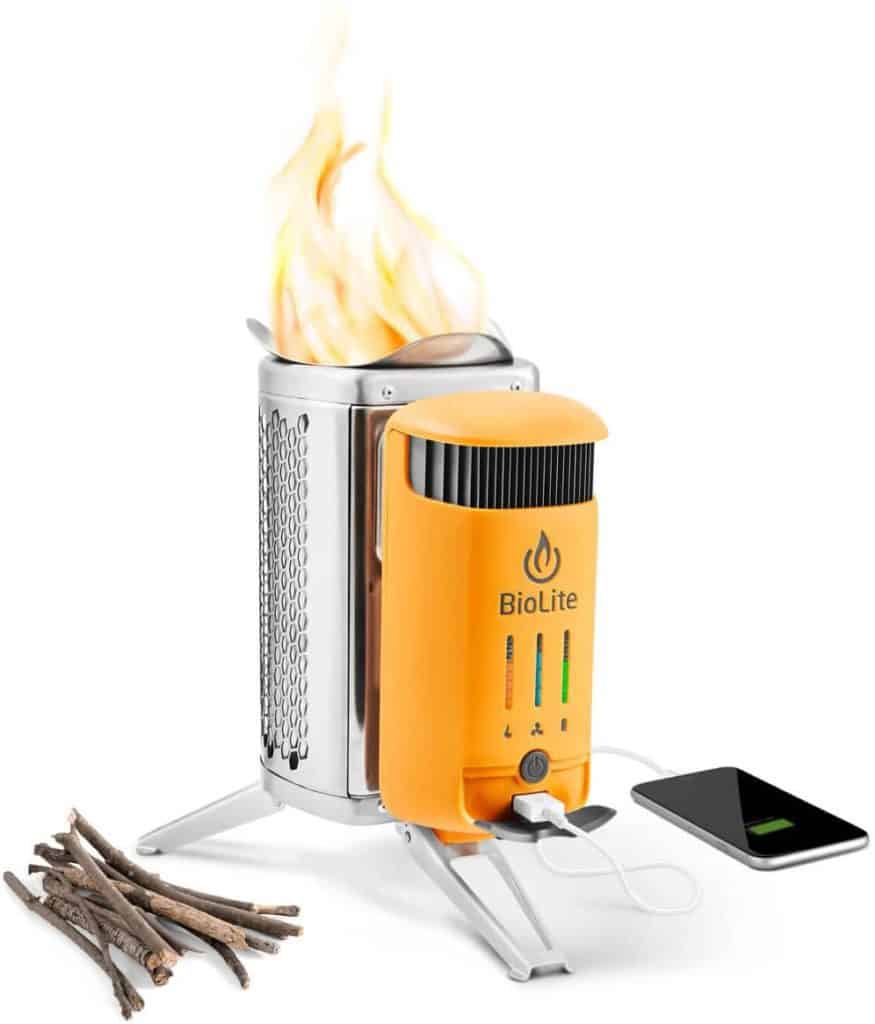
Tips for Effective Emergency Preparedness
When thinking about how to be prepared for an emergency, there are a few things that you will want to consider.
1.Have a plan in place.
If you live in an area that is prone to natural disasters such as hurricanes, floods, or forest fires, it’s important to have a plan that everyone in the household knows well. This should include:
- Where everyone is to meet,
- Who is in charge of grabbing what supplies, and
- What clothes should be worn.
2.Have an emergency kit prepared.
Each person should have a “go-bag” that has:
- A container for water and tablets to sanitize potentially contaminated water,
- Non-perishable food,
- A change of clothes including a rain slicker,
- A flashlight,
- A sleeping bag or blankets,
- First aid supplies,
- Important family papers,
- Your emergency communication device handbook,
- An extra set of house and car keys,
- Cash, and
- Extra batteries and USB charging cords (assuming you will have the means to charge devices).
This kit is important to take whether you are going to a disaster shelter, a different city, or your secret hiding place.
3.Regularly check your communication devices.
If a device is over-charged, it can damage the battery-life. Similarly, if it isn’t used enough, it can also fail. Make sure you know that your emergency communication devices are in operational order.
4.Keep the communication devices in an easy to find location.
In case of an emergency, you don’t want to have to second guess where you moved the walkie talkies. Keep them in the same location, or as near as possible, to the rest of your emergency supplies.
5.Make sure everyone knows how to use the communication devices.
During an emergency, our brains don’t work as clearly as when you aren’t stressed. Everyone needs to know how to work the emergency communication devices as easily as they know how to dial their mobile phone.
6.Keep open line communications brief and obscenity-free.
Even in a high-stress situation, everyone needs to remember that others may be listening in on your communications. This is one reason many of the devices have options for privacy codes.
Other Times Walkie Talkies are Beneficial
Although we wanted to help you prepare for an emergency, you don’t need to feel that is the only time you would necessarily want to use a walkie talkie.
The two-way radios are incredibly helpful to have when you:
- Go camping,
- Go hiking,
- Go biking,
- Go to the park,
- Go to the beach,
- Go to amusement parks, even when you
- Go to the mall.
Just because you want to be prepared for an emergency, doesn’t mean that you can’t still capture some of that childhood fun you had with these kinds of devices.
